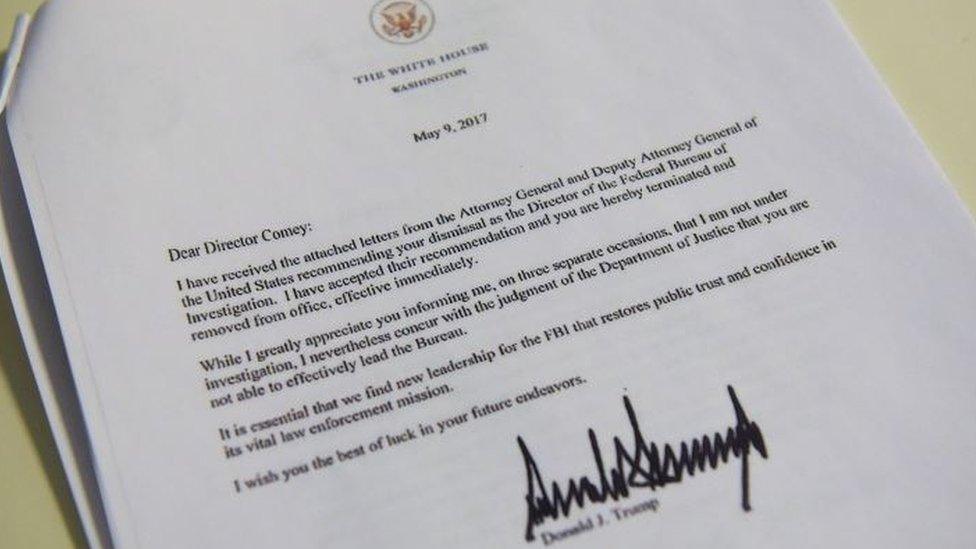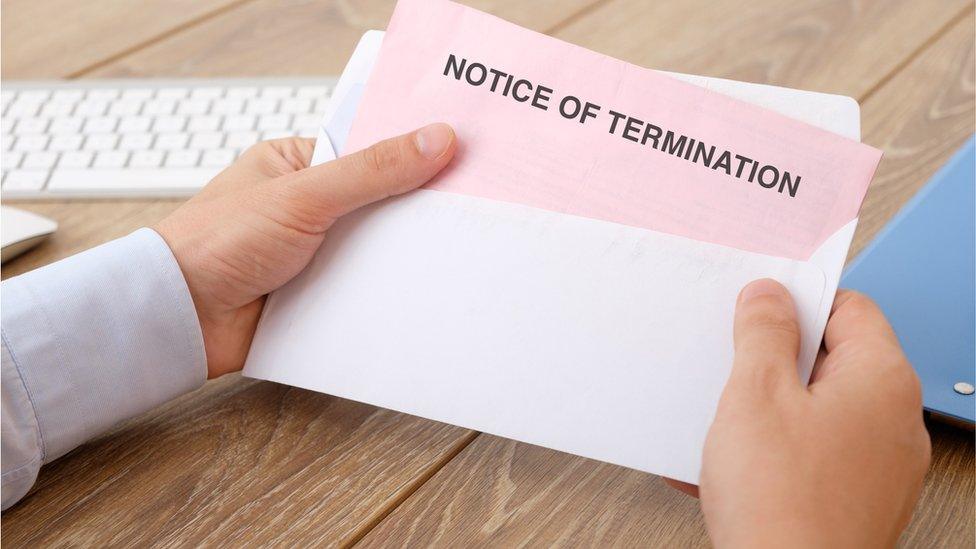You're fired! Top tips for getting a sacking right
- Published

Donald Trump's letter sacking FBI boss James Comey
It is not just Donald Trump's decision to fire FBI director James Comey that has raised eyebrows.
The way he was sacked, especially the termination letter, has come under scrutiny too.
So what tips do HR experts have for getting a sacking right?
Do it in person
Mr Comey's dismissal seems to have broken lots of conventional rules.
Firstly, he was not told personally by the President that he was out of a job.
Instead he was addressing FBI agents in Los Angeles when he saw the news on television. Aides had to pull him to one side and confirm it was not a prank.
Reaction to James Comey's sacking

President Trump did not tell Mr Comey of his decision in person
"That must have been very humiliating for him," says Rachel Suff, employment adviser at the Chartered Institute of Personnel and Development (CIPD).
"It has come out of the blue and so he (Trump) should have done it face to face."
Lucy Adams, chief executive of The Disruptive HR Agency (and former director of human resources at the BBC) agrees. "If you are going to fire someone, you should at least do it in person."
Get the letter right
What do you say in your dismissal letter?
"These break-up letters tend to fall into a number of categories," says Ms Adams.
She categorises them as 'It's not you, it's me', 'Can we stay friends?' or 'I never want to see you again.'
"Trump's letter has bits of all of these," she says.
"Most of all, though, a letter should reference the face to face conversations you have already had with them."
How to end such a letter is also a thorny subject. President Trump opted for: "I wish you the best in your future endeavours".
But Ms Adams says these letters should avoid such "platitudes".

President Trump's sign-off in his letter "came across as sarcastic", says Rachel Suff
Trump's sign-off was all wrong, agrees Rachel Suff.
"Given how short and terse the letter was, it just came across as sarcastic," she says.
But in more "normal circumstances" it would be good to end a letter of dismissal "on a positive, encouraging note", she adds.
Whether you're sacking someone in person or putting it in writing, the general message is keep it concise.
"Being to the point, and not having an hour-long chat about the last football game before sharing the decision is very important," says Jeannine Hertel, chief operating officer at the Singapore operation of recruitment firm Mercuri Urval.
It's not about you
Perhaps the most controversial section of Mr Trump's letter is its second paragraph.
This seemingly expressed gratitude to Mr Comey for telling him "on three separate occasions" that the President was exonerated from involvement in any Russian interference in the 2016 US election.

The letter highlighted Mr Comey's remarks that the President was exonerated from involvement in any Russian interference in the US election
On social media this has been derided as "ham-fisted" and "self-serving".
Says Lucy Adams, it brings "an incredible new dimension of self-absorption" to the world of sacking people.
Rachel Suff was equally unimpressed. "I couldn't believe Donald Trump's letter. Not only was it short, but a big chunk of it was about himself."
Thankfully this is very rare, she says, but adds it's important for bosses to remember that in employment, the balance of power is rarely equal.
"Resist using the situation for your own personal gratification."
Take responsibility
Another no-no in the Trump/Comey letter, according to our HR experts, was writing that the decision had been made following correspondence "from the attorney general and deputy attorney general... recommending your dismissal".

Mr Trump should have taken responsibility for his decision in his letter, say HR experts
"If you look at it, he's basically passing the buck, he's not really taking responsibility for it," says Rachel Suff.
And blaming others for the move did not sit well either with Jeannine Hertel.
"The manager in charge makes the decision and stands for the decision," she says.
"Never say it's the group management's decision or HR's decision and never ever push the responsibility away."
Lucy Adams agrees. "There's no right way to write a letter telling someone they're fired but in my experience it should be short and sweet and shouldn't try and pass the blame for the decision onto anyone."
Don't do it by Whatsapp....
Or email, or SMS, or on Facebook. It might sound crazy but firms have done just that., external

Mr Trump's move came as a surprise to Washington
"It's not a respectful way to connect with an individual," says Rosemary Guyatt, HR Manager at the Australian HR Institute.
"If someone is dismissed inappropriately you're going to have a very disgruntled ex-employee. A letter is the only correct way to put things in writing.
"A text message for example would be too brief and wouldn't constitute a legal document."
And quite apart from that, says Rachel Suff, word about how you treat staff would soon get round, which is likely to damage your brand.

If you're sacking someone - follow the law - otherwise you're likely to regret it
"In the days of social media reputation is everything."
Follow the law
Employment rules vary wildly across the world, but one bit of advice all our experts agreed on was that if you're sacking someone - follow the law.
"There's legislation in place to protect employees and if it's not a fair dismissal and the processes are not followed, it will come back to haunt you," says Rachel Suff.
Like Trump's letter to Comey, letters should be clear why someone is being dismissed and when the dismissal is effective from.
It should also address issues like compensation or outstanding payments.
"Make sure you check your contractual obligations," is Rosemary Guyatt's advice.
And remember....sacking should only be the last resort
"It's right that companies can sack people in the right circumstances and if proper processes have been followed," says Rachel Suff.

Before you fire somebody, you should have tried to improve things first
"But you can't sack someone willy-nilly."
When there's gross misconduct involved things are a little trickier. But most agree that before firing someone over performance, you need to have tried to improve things.
"The manager should have run several performance discussions, developed an improvement plan and made sure the employee has a fair chance to change his behaviour or actions," says Jeannine Hertel.
"And the employee should be aware what the process could finally lead to."
Which means that James Comey's dismissal seems to have broken another HR rule: that a termination should never be a total surprise.